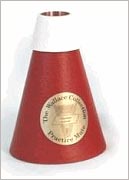The Wallace Practice Mute: A Comparative Review
 Using a practice mute has become a necessary evil for many trombonists. Whether out of courtesy while warming up for a gig, or for squeezing a few more minutes of practice into an already hectic daily schedule, practice mutes have become almost standard equipment for the working trombonist. Over the years, I have tried the Stonelined "Manny Kline Sh-Sh" mute, the tenor and bass trombone versions of the Denis Wick practice mute, the Yamaha Silent Brass, and most recently the Wallace Practice Mute. Each one is a trade-off, either offering better sound-deadening characteristics, or being freer-blowing. The Yamaha Silent Brass is a wonderful device, but the $300+ list price is prohibitive. The mute itself is very free-blowing, and has superior sound-deadening. The one drawback is the weight of the mute, which throws the balance point of the instrument much further towards the bell.
Using a practice mute has become a necessary evil for many trombonists. Whether out of courtesy while warming up for a gig, or for squeezing a few more minutes of practice into an already hectic daily schedule, practice mutes have become almost standard equipment for the working trombonist. Over the years, I have tried the Stonelined "Manny Kline Sh-Sh" mute, the tenor and bass trombone versions of the Denis Wick practice mute, the Yamaha Silent Brass, and most recently the Wallace Practice Mute. Each one is a trade-off, either offering better sound-deadening characteristics, or being freer-blowing. The Yamaha Silent Brass is a wonderful device, but the $300+ list price is prohibitive. The mute itself is very free-blowing, and has superior sound-deadening. The one drawback is the weight of the mute, which throws the balance point of the instrument much further towards the bell.
The Stonelined practice mute is more of a, "Well, I have to have one, and it's cheap" purchase. It does cause tuning problems, and the response of the instrument is drastically affected. The positive aspects of Stonelined practice mutes is that they are fairly quiet.
The Denis Wick mute is a very good option, fairly open, and has good sound deadening characteristics. I routinely use it to practice in my office, or at home after the kids are in bed. Unless you're in the same room, you'd have no idea someone is playing a trombone. However, the weight of the Denis Wick causes the same basic problem as the Yamaha Silent Brass - the balance point is shifted. Unless the you are careful, you will find yourself supporting some of the instrument weight with the slide hand. This is not conducive to good slide technique!
The Wallace practice mute weighs in at under 6 oz., and is very compact. I have used the mute on two different instruments, a Bach 50B3 bass and a Bach 42BO tenor. On the tenor with an 8-1/2" bell, it protrudes less than three inches from the bell. As with any mute, it does add a bit of weight to the bell section, causing a slight balance shift. However, this is minimal, almost indetectable. On the bass, the balance shift is truly indetectable.
The place where this mute truly shines, however, is not in the fit, weight, or appearance, it is in the playing. From pedal F to the top of the treble clef staff, it is the most open practice mute I have every used. With the Wick, the attacks sometimes falter because of the back pressure added by the mute. Unless the performer compensates with a slight increase of air on the attack, split attacks are frequent. The Wallace does not exhibit this characteristic, and feels as close to an open instrument as I believe any practice mute possibly can.
After using the Wallace mute for a month, I would highly recommend it to anyone looking for a practice mute. It is superior in its playing characteristics, and the level of sound deadening is acceptable.
Practice mutes are a necessary piece of equipment for many working musicians, but they are no substitute for practice on the open instrument. However, the Wallace mute is definitely a good investment, and is well worth the $49.95 price.
Pros: Light weight, excellent playing characteristics, compact size, performance-to-price ratio.
Cons: Fibre construction is not as durable as metal, Raises the pitch of the instrument slightly.
Wallace Music Products Web Site: http://www.wallacebrass.co.uk
